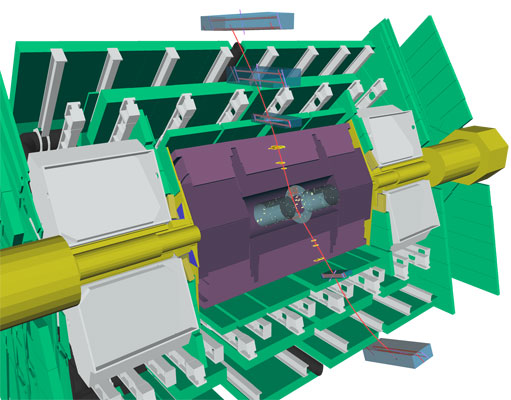
ATLAS e-News
23 February 2011
Muon/ID combined studies using cosmic data
6 April 2009

Event display showing a cosmic ray event crossing the whole ATLAS barrel recorded during the combined cosmic run 91890 (autumn 2008) with the full magnetic field on. A combined (inner detector and muon spectrometer) track is reconstructed in this event.
At the same time that the different ATLAS sub-detectors are being commissioned using cosmic rays data, studies of the overall performance of the detector have also started. During autumn 2008, several long global cosmic runs took place to collect a large amount of data. More than 216 million events were registered, reconstructed and processed during this period with different detector and magnet configurations to allow for specific studies. These are the most interesting events recorded so far since the whole detector was read out with the exception of the muon CSC chambers. This not only represents a new achievement of the ATLAS collaboration for the number of systems included, but also because nearly all of them were operating at full coverage.
These global cosmic runs have allowed performance studies of the combined muon reconstruction algorithms using the information of the different sub-detectors: the inner detector, the calorimeters and the muon spectrometer as shown on the above picture. However, before performing any combined reconstruction, one has to ensure that the two high precision tracking systems are well synchronised and aligned. Of course, this is not an easy task given the huge size of the detector. In the left plot of figure shown below, one can see the perfect correlation between the track parameter θ0 (angle with respect to the beam axis) when measured in the innermost or the outermost sub-detectors of ATLAS. Therefore combined tracks passing through the whole detector can be reconstructed, as shown in the event display above.
There are several combined algorithms for the reconstruction of muons, the global χ2 being one of them. This combined tracking algorithm associates muon tracks reconstructed in both tracking subsystems, then performs a common fit (taking into account material effects in the calorimeters) and provides a combined track with better momentum resolution. When a muon crosses the detector, its track is deflected due to multiple scattering with the material traversed and also it loses part of its energy. These effects depend on the muon momentum. Being the first time that all magnets have been used, the momentum could be measured and therefore these effects were taken into account. In the right plot of the figure shown below, the muon momentum measured in the muon chambers and in the inner detector for tracks reconstructed in the bottom half of ATLAS is compared. The difference between the measurements in the two sub-detectors is the energy deposited in the calorimeters. This result is of course encouraging and shows that the performance of the ATLAS detector is impressive.

Differences between quantities measured in the inner detector and in the muon spectrometer for both data and Monte Carlo: the left picture shows the angle θ0 and on the right picture, the momentum. A simulation of cosmic rays going through the ATLAS detector has also been provided to allow for data/Monte Carlo comparisons.

María Moreno LlácerIFIC, Valencia, Spain
|